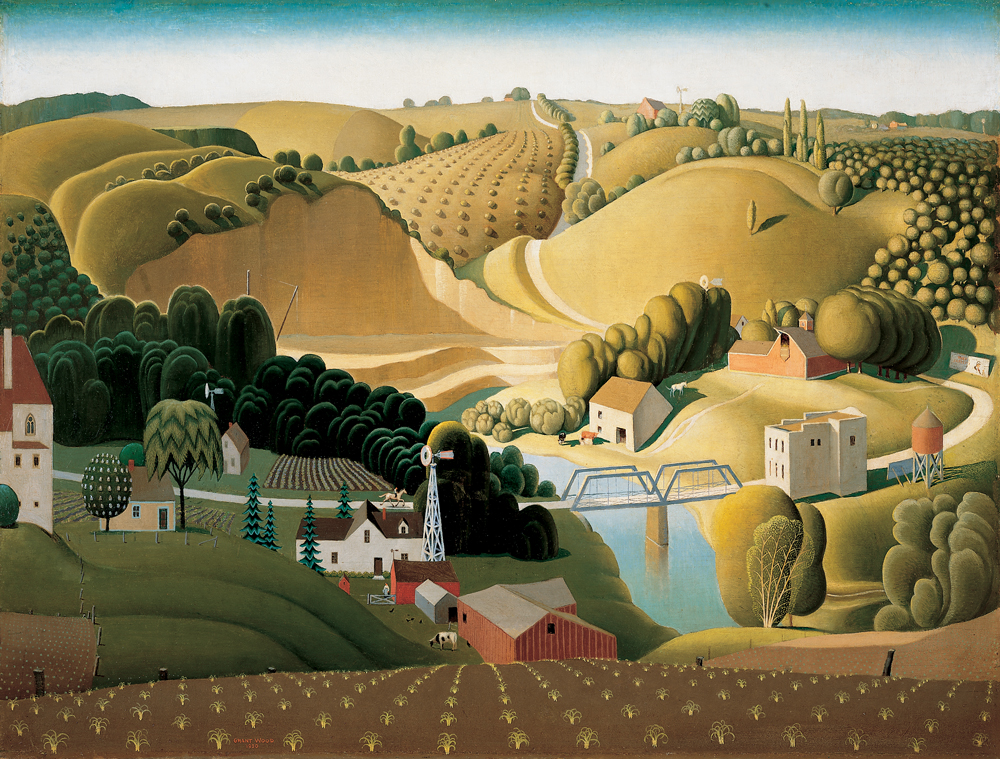Main navigation
The roots of Grant Wood’s artist colonies date back to the 1920s and 1930s when Wood gathered writers, artists, and craftspeople to collaborate in Cedar Rapids, Stone City, and Iowa City.
His vision to form a community of kindred spirits has materialized at the University of Iowa through the Grant Wood Art Colony.

Stone City, 1930. Joslyn Art Museum, Omaha, Nebraska; gift of the Art Institute of Omaha 1930.35.
This painting depicts Stone City, Iowa, the location of the original Art Colony that Grant Wood started in 1932.
1142
Grant Wood affectionately called his Iowa City home 1142, for its location at 1142 East Court Street.
In 1934, Grant Wood was offered a position working and teaching in Iowa City as Director of a New Deal Public Works of Art Program (P.W.A.P.). While headquartered in Iowa City and associated with the University of Iowa, he assisted other artists and art students in producing a set of murals for Iowa State University in Ames, Iowa. Once his P.W.A.P. concluded in 1934, the University of Iowa offered a three-year-term as an Associate Professor of Fine Art.
Wood moved in to 1142 in 1935 after having commuted from his 5 Turner Alley Studio to Iowa City for a year. This move coincided with his marrying Sara Moxon. During the next two years, Wood made the house his own through extensive renovation. He designed his own furniture, restored historic features, and changed the landscaping. Wood created many lithographs while at the house, including those for the Associated American Artists, and he featured 1142 in Parson Weems' Fable in 1939. Wood lived in this home and continued to teach at the University until his death in 1942. He is said to have considered his restoration of 1142 as is finest artistic achievement.
1142 is not open to the public. However, 1142 has continued to evolve and grow richer in its history over the years as a residence and center of conversation. In 1978 the house was placed in the National Register of Historic Places. A documentary about 1142 was produced in 2016.
The Grant Wood Art Colony is located directly behind 1142, along Burlington Street. Four red houses, detailed in forest green are home to the Fellows and administrative office.
1142: Beyond the Bricks
In 1856, a local brick manufacturer, Nicholas Oakes, completed the building of his house at 1142 East Court Street in Iowa City. Since then, each owner of 1142 has both nurtured and been nurtured by this significant and beautiful home. Noted regional artist, Grant Wood, internationally celebrated for his American Gothic, lived, worked, and entertained an extensive array of fellow artists and writers while living at 1142. Pioneering physician, Pauline Moore, raised her family in 1142, establishing herself as a leading family physician. Current owner, distinguished attorney, James P. Hayes, has meticulously and graciously restored the home, enriching the interiors with original art and noteworthy antiques.
This documentary chronicles the owners of 1142. The rich history of 1142 is brought to life through stories and anecdotes about the people who both owned and visited the home.
The documentary was made with support for the University of Iowa Foundation.
The Iowa Idea: bringing artists and scholars together
This year I am at the University of Iowa. I am here with the understanding that I am to spend most of my time writing, with only two mornings a week of teaching. The university is very friendly to the idea, as they also have a painter, Grant Wood, under the same scheme. The idea is that a university should be a center of all culture, not just of scholarship, and that students who wish to be helped with painting or writing or music can have someone to who is practicing the art in which they are interested.
Paul Engle, November 20, 1937
Long-time director of the Iowa Writers' Workshop and founder of the International Writing Program
A Brief History of the Grant Wood Art Colony at the University of Iowa

Local lawyer, Jim Hayes, purchased 1142 in 1975. In the early 2000s, Hayes signed a gift agreement promising to bequeath the property to the University upon his death. Over time, Hayes collected four parcels—1131, 1137, 1205, and 1211 East Burlington Street. This addition led to the expansion of his posthumous vision for 1142 to include a rotating community of artists modeled after the colonies that Wood tried to establish in his lifetime.
Rather than awaiting his own death to see this vision to fruition, Hayes began discussions with the University of Iowa in 2009. Hayes hosted the first Grant Wood Symposium on May 7, 2009 at 1142. In 2011, the first Grant Wood Fellow was hosted in the Obermann Center for Advanced Studies. Since that year, the Grant Wood Art Colony has held several symposia focusing on the life, times, and legacy of Grant Wood and annually hosted Grant Wood Fellows in painting and drawing, printmaking, and interdisciplinary performance.
Having transferred from the Obermann Center to the School of Art & Art History, the breadth of scope led the program to again move. In 2015, the Grant Wood Art Colony joined the Provost’s Office of Community Engagement.